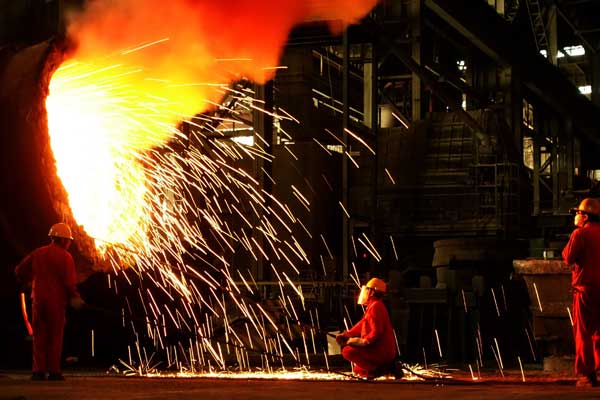SOEs post 18.6 pct profits in first half of year, official says
The central government's State-owned enterprises posted better-than-expected net profits of 535.32 billion yuan ($78.66 billion) in the first half of the year, thanks to supply-side reform, innovation and curbs on capital outflow, the country's top SOE regulator said on July 11.
|
|
|
Workers clean a molten steel holder at a steel plant in Dalian, Liaoning province. [Photo/China Daily] |
The half-year profits represent a year-on-year growth of 18.6 percent, with double-digit growth each month.
Profits in June reached 159.67 billion yuan, hitting a record high since the statistics became available. Of the 102 central SOEs, 99 were in the black, 48 had profits grow by more than 10 percent and 29 had profits increase by more than 20 percent.
Shen Ying, chief accountant of the State-owned Assets Supervision and Administration Commission, said the government will further tighten State capital supervision, enhance risk control and deepen SOE reform by cutting unnecessary administrative bodies, strengthening debt risk control and applying capital outflow restraints.
"The debt to asset ratio has been declining steadily and the capacity to repay debt has been enhanced in most central SOEs between January and June, thanks to measures to improve debt risk control, optimize capital structure, steadily advance market-based debt to equity swaps and thoroughly identify risks in bond redemption," Shen said.
The total revenue of central SOEs amounted to 12.5 trillion yuan in the first half of 2017, up 16.8 percent year-on-year, also seeing double-digit growth for six consecutive months.
A total of 5.95 million metric tons of steel overcapacity was eliminated between January and June, ahead of the timeline for the year. In the coal industry, 6.59 million metric tons of overcapacity has been cut.
"Reforms will explore use of new State-owned asset management models emphasizing the management of capital instead of the companies, find effective methods for a mixed-ownership economy, and improve the corporate governance structure," said Huang He, a global partner of consulting firm McKinsey & Co.
Eager to enhance their earning ability, COSCO Shipping Holdings Co, a subsidiary of China COSCO Shipping Corp, and Shanghai International Port (Group) Co made a conditional offer on Sunday to all shareholders of Hong Kong-based Orient Overseas (International), Ltd to acquire all issued shares in cash.
Under the $6.3 billion deal, COSCO Shipping Holdings would operate more than 400 vessels over an expanded network, with capacity exceeding 2.9 million twenty-foot equivalent units. The units are the approximate size of a standard shipping container.
"COSCO Shipping Lines will become the world's third-largest container shipping operator after Denmark's Maersk Line and Switzerland's Mediterranean Shipping Co SA," said Zhao Ying, a researcher at the institute of industrial economics of the Chinese Academy of Social Sciences in Beijing.
